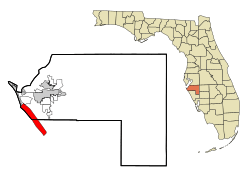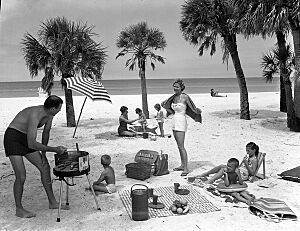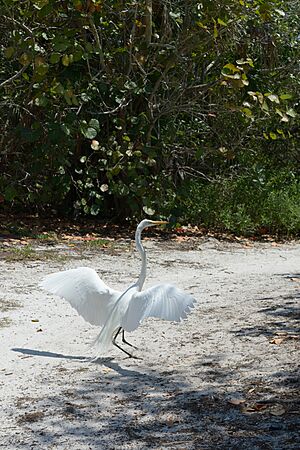Longboat Key, Florida facts for kids
Quick facts for kids
Longboat Key, Florida
|
|
|---|---|
| City of Longboat Key | |

View of Millar bay and Sister Keys from a Longboat Keys residence
|
|
| Motto(s):
Premier Community, Exceptional Service
|
|

Location in Manatee County and the state of Florida
|
|
| Country | |
| State | |
| Counties | Sarasota, Manatee |
| Settled | 1842-1891 |
| Incorporated | November 13, 1955 |
| Government | |
| • Type | Commission–manager |
| Area | |
| • Total | 16.00 sq mi (41.44 km2) |
| • Land | 4.08 sq mi (10.56 km2) |
| • Water | 11.92 sq mi (30.88 km2) |
| Elevation | 3 ft (1 m) |
| Population
(2020)
|
|
| • Total | 7,505 |
| • Density | 1,840.36/sq mi (710.54/km2) |
| Time zone | UTC-5 (Eastern (EST)) |
| • Summer (DST) | UTC-4 (EDT) |
| ZIP code |
34228
|
| Area code(s) | 941 |
| FIPS code | 12-41150 |
| GNIS feature ID | 0286084 |
Longboat Key is a town in Manatee and Sarasota counties. It is located on the central west coast of Florida, on a narrow island called a barrier island. This island sits between Sarasota Bay and the Gulf of Mexico. Longboat Key is south of Anna Maria Island. The town became official in 1955. It is part of a larger metropolitan area that includes Bradenton and Sarasota. In 2020, about 7,505 people lived there.
Contents
History of Longboat Key
Early Days and First Explorers
Longboat Key was first home to Native Americans. The first European to explore the area was Juan de Añasco. He was a scout for Hernando de Soto in the 1500s. Añasco spent about two months looking for a good landing spot. He was likely the first European to see Sarasota Bay. Local stories say he thought the Native Americans were unfriendly. When his group landed, the Native Americans left their longboat behind. Some legends even say the pirate Jean Lafitte was shipwrecked near Longboat Key.
Before 1842, Cuban and Spanish fishermen lived on the island. They also had trading posts for Native Americans. An old map from 1839 called the island "Palm Island." Not much is known about the island between 1848 and the 1880s. A big hurricane hit the area and destroyed most of Longboat Key.
Settlers and Early Development
The first Europeans to claim land on the island were Colin and Rowlin W. Witt in 1882. They claimed a small piece of land on the north end. Many others claimed land, but they didn't live there all the time.
In 1884, Thomas Mann claimed a larger area of land. He and his family moved there in 1888. They were the first known people to live on the key permanently. Thomas Mann was a carpenter from Indiana. He had served in the American Civil War. His home was on the north end of the key.
In 1895, a new passage was dug connecting Sarasota Bay to Tampa Bay. This allowed steamships to reach the island. Soon, a mail service started, bringing mail from nearby Cortez.
Longboat Key's first post office opened in 1907. It was at Byron Corey's pier on the southern end of the island. Corey was also the first postmaster. This post office was destroyed by a hurricane in 1921.
Growth and Changes in the 1900s
The early 1900s brought many changes to the key. In 1911, Rufus Perry Jordan created a community called Longbeach on the north end. Another area called Shore Acres was developed in 1913. Farming was very important on Longboat Key before the 1921 hurricane. Farmers grew many different crops. A newspaper headline from 1912 said the key was becoming a "center of trucking and fruit growing."
In 1921, a hurricane destroyed most of the farms and buildings. That same year, the island was split between two counties: Sarasota and Manatee.
Starting in 1923, John Ringling, a famous circus owner, bought a lot of land on Longboat Key. In 1926, he planned to build a fancy hotel called the Ritz-Carlton. It was supposed to have over 200 rooms and a golf course. But Ringling had other projects, and the Florida land boom slowed down. He stopped construction on the hotel, and it was never finished.
For a long time, there were no roads to the key. The first bridge was built in 1929, connecting it to St. Armands.
Mid-20th Century and Incorporation
In 1935, a man named Gordon Whitney started buying land to build cottages. This area became known as Whitney Beach. He wanted the cottages to be part of a resort.
Telephone service came to the southern part of the island in 1936. By 1939 or 1940, the whole island had phone service. Longboat Key got its first newspaper, Gulf Gale, in 1941.
During World War II, Longboat Key was used as a bombing range. Airplanes like the B-26 and P-51 practiced bombing there. This meant residents on the north side couldn't go south during training hours.
On November 13, 1955, the town officially became incorporated. This means it became its own town with its own government. People voted 186 to 13 to make it a town. They wanted more say in how their community was run. Some also wanted to prevent a segregated beach from being built on the island. Will LePage was elected as the first mayor. At that time, only about a third of Longboat Key was developed, and about 215 people lived there. When it became a town, its name changed from Longbeach to Longboat Key.
In 1959, a company called Arvida Corporation bought 2,000 acres of land. This included the southern half of Longboat Key. The unfinished Ritz-Carlton Hotel was on this land. There were ideas to finish the hotel, but Arvida decided not to. The hotel was torn down between 1963 and 1964. Parts of the old hotel were used to fill land for the city's civic center.
In early 2024, it was announced that a new public library will be built on Longboat Key. It will be part of the Sarasota County Library System.
Geography and Natural Beauty
Longboat Key covers about 41.4 square kilometers (16 square miles). Most of this area, about 30.7 square kilometers (11.9 square miles), is water. The land area is about 10.7 square kilometers (4.1 square miles).
Longboat Key is north of St. Armands Key, which is known for its shops and restaurants. It is also north of Lido Key. To the north of Longboat Key are Bradenton Beach, Holmes Beach, and Anna Maria, all on Anna Maria Island. The nearby cities of Sarasota and Bradenton are also close. The Sarasota–Bradenton International Airport is nearby too.
A main road, State Road 789 (Gulf of Mexico Drive), runs the entire length of the island. Smaller roads branch off to neighborhoods. From some spots on the island, you can see both Sarasota Bay and the Gulf of Mexico.
The island gets wider in some places. Here you'll find homes, condominiums, hotels, and sports clubs. Many people who live on Longboat Key are "snowbirds." This means they own second homes here and visit mostly during the winter months. Other people live there all year round.
Most of the side of Longboat Key facing the Gulf of Mexico has beautiful beaches. The very southern part of the key is mostly taken up by the Longboat Key Club.
Jewfish Key: A Nearby Island
Jewfish Key is a small island of about 38 acres (150,000 square meters) within the town's limits. You can only get to this island by boat. The eastern part of Jewfish Key is a nature reserve. Electricity comes to the island through underwater cables. There are no landline phones, and residents get water from wells.
Until the 1930s, Jewfish Key was actually two separate islands. When the US Army Corps of Engineers dug the Intracoastal Waterway, they needed a place to put the extra dirt. The owners of the two islands allowed the dirt to be placed there. This created one larger island. The island got its name because local fishermen used to catch many large Goliath groupers, also known as Jewfish, there.
Water Supply for the Island
For a long time, getting enough clean water was a challenge for Longboat Key residents. The saltiness of the water and sand in the supply were problems. This issue was mostly solved when Longboat Key connected to Sarasota County's water supply. This added to the water they already got from Manatee County.
Population and People
| Historical population | |||
|---|---|---|---|
| Census | Pop. | %± | |
| 1960 | 1,000 | — | |
| 1970 | 2,850 | 185.0% | |
| 1980 | 4,843 | 69.9% | |
| 1990 | 5,937 | 22.6% | |
| 2000 | 7,603 | 28.1% | |
| 2010 | 6,888 | −9.4% | |
| 2020 | 7,505 | 9.0% | |
| U.S. Decennial Census | |||
The population of Longboat Key has changed over the years. In 2010, there were 6,888 people living in the town. By 2020, the population had grown to 7,505 people. This means more people are choosing to live in Longboat Key.
Longboat Key's Diverse Community
Longboat Key is home to a mix of people. The population includes different racial and ethnic groups. Most residents are White. There are also smaller numbers of Black or African American, Native American, Asian, and people of two or more races. A small percentage of the population is of Hispanic or Latino background.
Famous People from Longboat Key
Many interesting people have lived in Longboat Key, including:
- Al Arbour, a famous hockey coach who won the Stanley Cup four times with the New York Islanders.
- Marilyn Bendell, an artist known for her impressionist paintings.
- Lou Bender, a basketball player and trial attorney.
- Nick Bollettieri, who started a well-known tennis academy in Bradenton.
- Vern Buchanan, a car dealer and a member of the U.S. House of Representatives for Florida.
- Frank Swift Chase, a post-impressionist painter.
- Harber H. Hall, a former member of the Illinois Senate.
- Marcella Hazan, a famous Italian cooking teacher and cookbook author.
- Tom Helmore, an actor.
- Audrey Hepburn, a very famous actress.
- Al Hirshberg, a sportswriter from Boston.
- Nathan J. Kaplan, an Illinois judge and politician.
- Jesse W. Markham, an economist.
- Charlie Maxwell, a baseball player for teams like the Detroit Tigers.
- Peter Mellor, an English-born American soccer player and coach.
- Ed Miracle, an artist.
- Frank Mockler, a former Governor of American Samoa.
- Ronna Romney, a former Republican politician from Michigan.
- Reb Wickersham, a racing driver.
See also
 In Spanish: Longboat Key para niños
In Spanish: Longboat Key para niños






